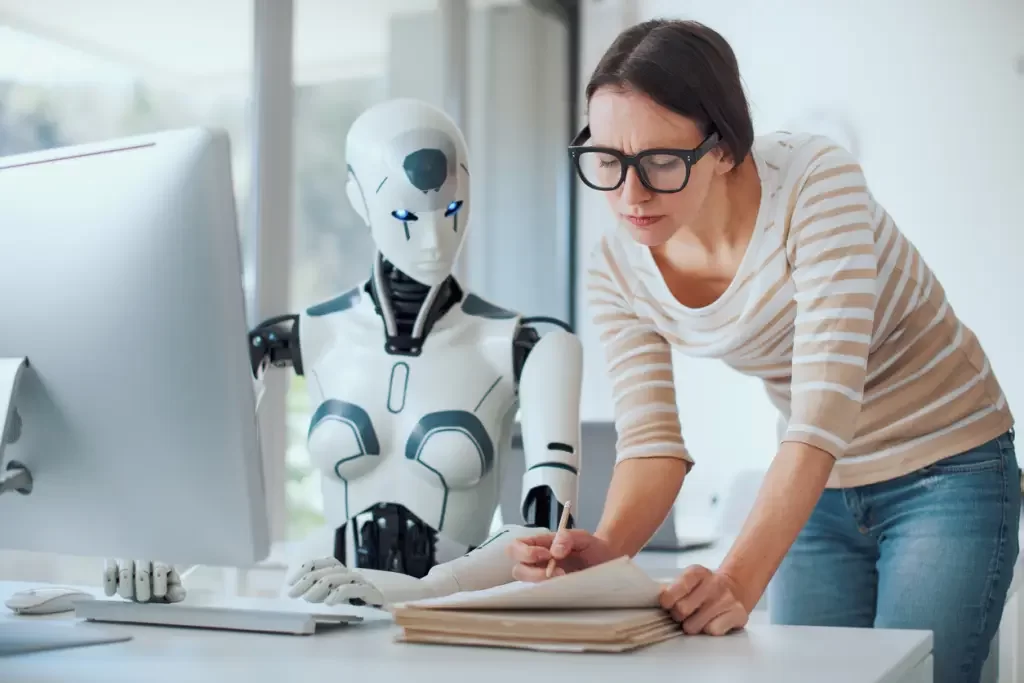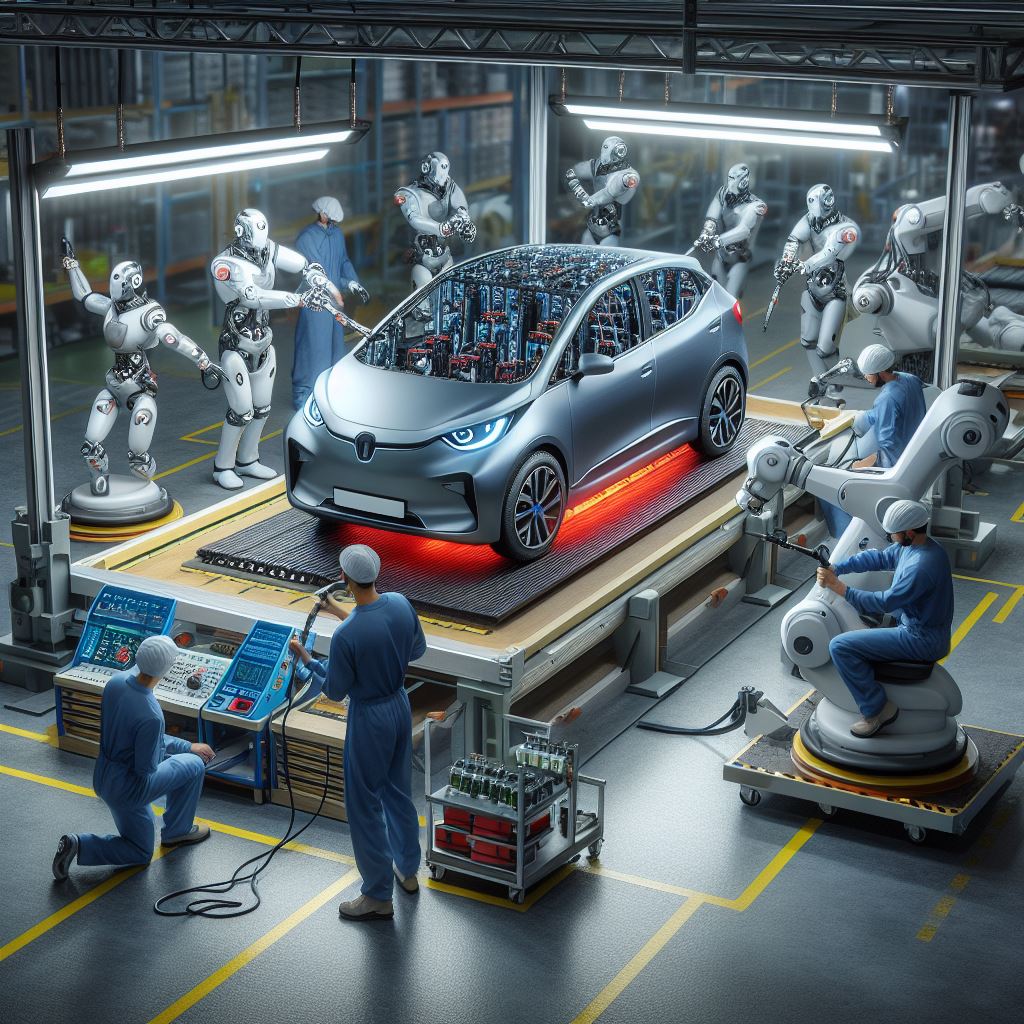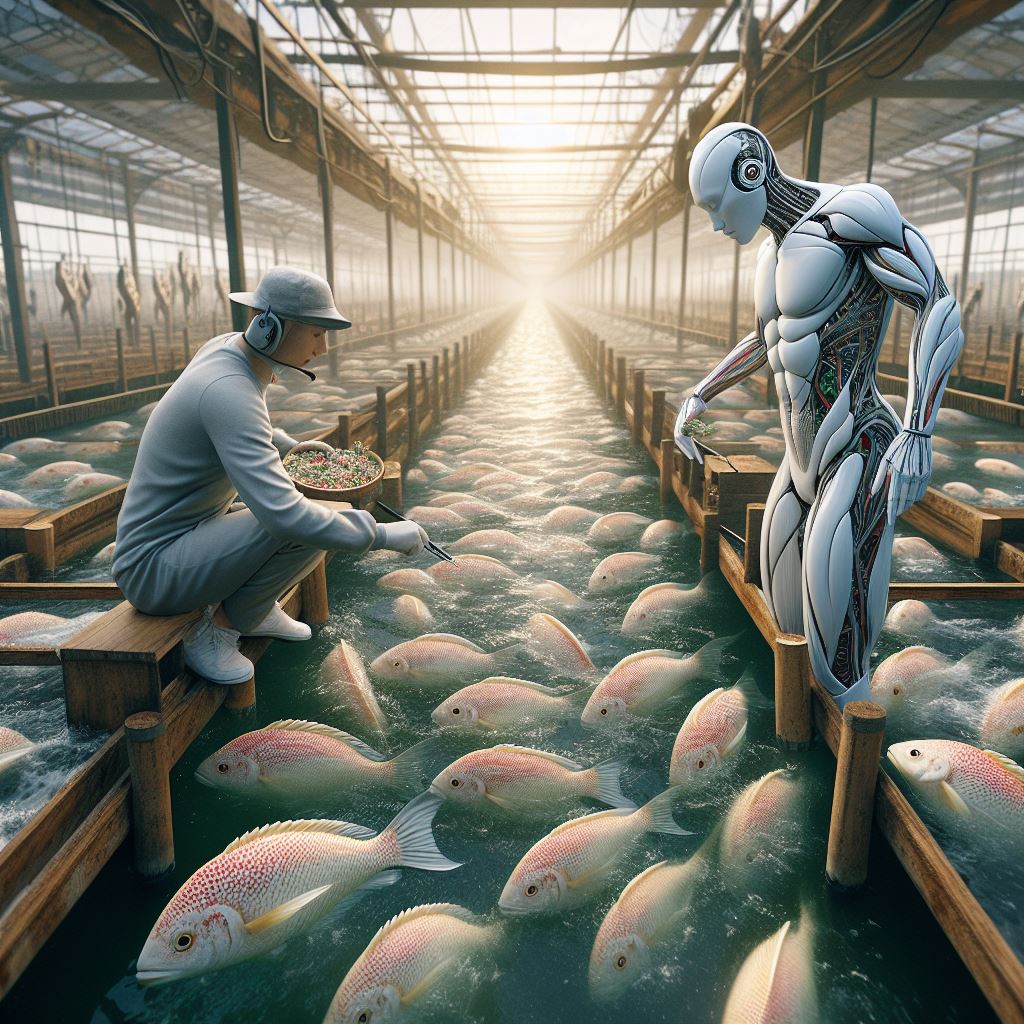Contents
- 1 How Humans and Machines Can Work Together To Solve Complex Problems and Create Value
- 2 Prof. Aécio D’Silva, Ph.D AquaUniversity
- 3
- 4 How does human and AI collaborative intelligence work?
- 5 What are some of the potential benefits and challenges of human and AI collaborative intelligence?
- 6 How do overcome the challenges of human and AI collaborative intelligence?
- 7
- 8 What are some examples of human and AI collaborative intelligence?
How Humans and Machines Can Work Together To Solve Complex Problems and Create Value
Prof. Aécio D’Silva, Ph.D
AquaUniversity
In many of my collaborative intelligence leadership publications, I’ve underscored the benefits of collaborative intelligence as a pathway to attaining total excellence. Beginning with the truth that “we” collectively possess greater intelligence than “I” alone. Presently, we’re faced with a more intricate and demanding task: exploring the potential and hurdles of human-AI collaboration in practical settings. Human and AI collaborative intelligence is the idea that humans and artificial intelligence (AI) systems can combine their strengths and capabilities to achieve better outcomes than either could alone. It is based on the premise that humans and machines have complementary skills and abilities and that by working together, they can enhance each other’s performance and learning. In this blog post, we will explore what human and AI collaborative intelligence is, how it works, and what are some of the potential benefits and challenges of this approach.
Artificial intelligence (AI) is transforming all sectors of the economy, society, and culture, by enabling machines to perform tasks that require human-like intelligence, such as perception, reasoning, decision-making, and communication. However, AI is not a substitute for human intelligence, but rather a tool that can augment and assist it. Humans and machines have different strengths and weaknesses, and by collaborating, they can leverage their respective advantages and overcome their limitations.
Human and AI collaborative intelligence is the concept that humans and machines can work together as partners, rather than as competitors or substitutes, to solve complex problems and create value. It is based on the recognition that humans and machines have different types of intelligence and that by integrating them, they can achieve synergies and efficiencies. Human and AI collaborative intelligence can be seen as a form of collective intelligence, which is the ability of a group of individuals or entities to pool their resources and knowledge to achieve a common goal.
How does human and AI collaborative intelligence work?
Human and AI collaborative intelligence works by combining the cognitive and social abilities of humans with the analytical and computational abilities of machines. Humans and machines can interact and communicate with each other, share information, and feedback, and coordinate their actions and decisions. Human and AI collaborative intelligence can take different forms and levels, depending on the degree of autonomy and interdependence of the human and machine agents, and the nature and complexity of the task or problem.
Human-in-the-loop
Human-in-the-loop is a form of human and AI collaborative intelligence where humans are involved in the process of supervising, monitoring or correcting the AI system. Humans can provide inputs, guidance, or validation to the AI system, or intervene when the AI system makes errors or faces uncertainties. For example, humans can train, label, or annotate data for the AI system, or review, edit, or approve the outputs of the AI system. Human-in-the-loop can help ensure the quality, accuracy, and reliability of the AI system, as well as the ethical and social implications of its actions and decisions.
Human-on-the-loop
Human-on-the-loop is a form of human and AI collaborative intelligence where humans are involved in the process of overseeing, evaluating, or auditing the AI system. Humans can observe, analyze, or measure the performance, behavior, or impact of the AI system, or provide feedback, suggestions, or recommendations to the AI system. For example, humans can monitor, test, or benchmark the AI system, or adjust, optimize, or improve the parameters, algorithms, or models of the AI system. Human-on-the-loop can help ensure the efficiency, effectiveness, and accountability of the AI system, as well as the alignment of its goals and values with those of humans.
Human-in-the-loop
Human-in-the-loop is a form of human and AI collaborative intelligence where humans are involved in the process of collaborating, cooperating, or co-creating with the AI system. Humans and machines can exchange information, ideas, or perspectives, and jointly perform tasks, make decisions, or generate solutions. For example, humans and machines can brainstorm, design, or innovate together, or complement, assist, or support each other. Human-in-the-loop can help enhance the creativity, productivity, and learning of both the human and the machine, as well as the satisfaction and engagement of the human.
What are some of the potential benefits and challenges of human and AI collaborative intelligence?
Human and AI collaborative intelligence has the potential to bring many benefits and opportunities for individuals, organizations, and society, such as:
- Improving the quality and speed of decision-making and problem-solving, by combining the intuition, judgment, and experience of humans with the data, logic, and computation of machines.
- Enhancing the innovation and creativity of products and services, by combining the imagination, diversity, and empathy of humans with the intelligence, scalability, and personalization of machines.
- Increasing the efficiency and productivity of processes and operations, by combining the flexibility, adaptability, and resilience of humans with the automation, optimization, and accuracy of machines.
- Enabling new forms of learning and education, by combining the curiosity, motivation, and socialization of humans with the knowledge, analysis, and feedback of machines.
- Empowering new forms of work and collaboration, by combining the skills, talents, and passions of humans with the capabilities, resources, and opportunities of machines.
However, human and AI collaborative intelligence also poses some challenges and risks that need to be addressed and mitigated, such as:
- Ensuring the trust and transparency of the AI system, by making it explainable, interpretable, and understandable for the human, and by providing clear and consistent information and communication.
- Ensuring the fairness and accountability of the AI system, by avoiding or reducing bias, discrimination, or harm to human or other stakeholders, and by providing mechanisms for oversight, regulation, or redress.
- Ensuring the security and privacy of the AI system, by protecting the data, information, and systems from unauthorized access, use, or manipulation, and by respecting the rights and preferences of the human or other stakeholders.
- Ensuring the compatibility and interoperability of the AI system, by designing it to be compatible and interoperable with the human and other systems, and by providing standards, protocols, or interfaces for integration and coordination.
- Ensuring the adaptability and sustainability of the AI system, by designing it to be adaptable and sustainable to the changing needs, preferences, and contexts of the human and the environment, and by providing mechanisms for updating, maintaining, or retiring the system. [1, 2]
How do overcome the challenges of human and AI collaborative intelligence?
Human and AI collaborative intelligence, as we said above, is the concept that humans and machines can work together as partners, rather than as competitors or substitutes, to achieve better outcomes than either could alone. However, this approach also poses some challenges and risks that need to be addressed and mitigated, such as trust, fairness, security, compatibility, and adaptability. Here are some possible ways to overcome these challenges:
- To overcome the challenge of trust and transparency, humans and machines need to communicate and explain their actions and decisions to each other and provide clear and consistent information and feedback. Humans need to understand the capabilities, limitations, and assumptions of the AI system, and the AI system needs to provide explanations, justifications, and evidence for its outputs and behaviors. This can help build trust, confidence, and collaboration between humans and the machine. [1,4]
- To overcome the challenge of fairness and accountability, humans and machines need to avoid or reduce bias, discrimination, or harm to humans or other stakeholders, and provide mechanisms for oversight, regulation, or redress. Humans need to ensure that the AI system is aligned with human values, goals, and norms and that the AI system is responsible for its actions and decisions. The AI system needs to follow ethical and social principles and provide ways to monitor, audit, or correct its actions and decisions. This can help ensure fairness, justice, and accountability for the human and the machine. [1, 4]
- To overcome the challenge of security and privacy, humans and machines need to protect the data, information, and systems from unauthorized access, use, or manipulation, and respect the rights and preferences of the human or other stakeholders. Humans need to ensure that the AI system is secure, reliable, and robust and that the AI system respects the privacy, consent, and ownership of the data and information. The AI system needs to follow security and privacy standards and protocols and provide ways to encrypt, anonymize, or delete data and information. This can help ensure security, privacy, and protection for the human and the machine. [1, 4]
- To overcome the challenge of compatibility and interoperability, humans and machines need to design the AI system to be compatible and interoperable with human and other systems, and provide standards, protocols, or interfaces for integration and coordination. Humans need to ensure that the AI system is user-friendly, intuitive, and adaptable and that the AI system can communicate and cooperate with humans and other systems. The AI system needs to follow compatibility and interoperability guidelines and specifications and provide ways to integrate, coordinate, or synchronize with humans and other systems. This can help ensure compatibility, interoperability, and harmony for humans and machines.
- To overcome the challenge of adaptability and sustainability, humans and machines need to design the AI system to be adaptable and sustainable to the changing needs, preferences, and contexts of the human and the environment, and provide mechanisms for updating, maintaining, or retiring the system. Humans need to ensure that the AI system is flexible, scalable, and resilient and that the AI system can learn and improve from humans and the environment. The AI system needs to follow adaptability and sustainability principles and practices and provide ways to update, maintain, or retire the system. This can help ensure adaptability, sustainability, and continuity for the human and the machine.
These are some of the possible ways to overcome the challenges of human and AI collaborative intelligence, but there are many more in different fields and domains. To achieve human and AI collaborative intelligence, humans and machines need to work together as partners, rather than as competitors or substitutes, and leverage their complementary skills and abilities. Human and AI collaborative intelligence is one of the most promising and exciting developments of the 21st century, and it will continue to shape the future of humanity and technology. [1, 4, 5]
What are some examples of human and AI collaborative intelligence?
Human and AI collaborative intelligence is the concept that humans and machines can work together as partners, rather than as competitors or substitutes, to achieve better outcomes than either could alone. It is based on the recognition that humans and machines have different types of intelligence and that by integrating them, they can achieve synergies and efficiencies. Here are some examples of human and AI collaborative intelligence from various fields and domains:
- Search and rescue missions: Smart drones work alongside human teams to scan terrain and deliver immediate support. Humans can provide inputs, guidance, or validation to the drones, or intervene when the drones face uncertainties. [1]
- Storytelling: The Shelley AI bot tweets short horror story ideas and invites people to create collaborative horror tales. Humans and machines can exchange information, ideas, or perspectives, and jointly generate solutions. [1]
- Music: Flow Machines Professional helps musicians collaborate with AI to create original compositions. Humans can feed their music ideas and inspiration into the AI, which will generate new melodies, accompaniments, and instrumentation.
- Healthcare: Pathology-AI helps pathologists collaborate with AI to diagnose diseases from tissue samples. Humans can monitor, analyze, or measure the performance, behavior, or impact of the AI, or provide feedback, suggestions, or recommendations to the AI.
- Education: Squirrel AI Learning helps students collaborate with AI to learn better. The AI system adapts to the student’s learning styles, preferences, and progress, and provides personalized content, guidance, and feedback. Students can also interact with human teachers and peers through the AI system. [2]
- Work: Slack helps workers collaborate with AI to communicate and coordinate better. The AI system helps workers find relevant information, people, and channels and provides suggestions, reminders, and insights. Workers can also customize and optimize the AI system according to their needs and goals.
Concluding, Human and AI collaborative intelligence is the idea that humans and machines can work together as partners, rather than as competitors or substitutes, to achieve better outcomes than either could alone. It is based on the premise that humans and machines have complementary skills and abilities and that by working together, they can enhance each other’s performance and learning. Human and AI collaborative intelligence can take different forms and levels, depending on the degree of autonomy and interdependence of the human and machine agents, and the nature and complexity of the task or problem. Human and AI collaborative intelligence has the potential to bring many benefits and opportunities for individuals, organizations, and society, but it also poses some challenges and risks that need to be addressed and mitigated. Human and AI collaborative intelligence is one of the most promising and exciting developments of the 21st century, and it will continue to shape the future of humanity and technology.
References
[1] https://hbr.org/2018/07/collaborative-intelligence-humans-and-ai-are-joining-forces
[2] https://www.csiro.au/en/news/All/Articles/2023/July/collaborative-intelligence
[3] https://www.ucf.edu/news/researchers-identify-6-challenges-humans-face-with-artificial-intelligence/
[5]: Zeller, F., Dwyer, L. Systems of collaboration: challenges and solutions for interdisciplinary research in AI and social robotics. Discov Artif Intell 2, 12 (2022). https://doi.org/10.1007/s44163-022-00027-3








